WHY DO WE FALL ILL? for Class 9 BIOLOGY
INTRODUCTION
- Health and disease in human communities are very complex issues, with many interconnected causes. The ideas of what ‘health’ and ‘disease’ mean are themselves very complicated. Cells are made of a variety of chemical substances–proteins, carbo-hydrates, fats or lipids, and so on. Cell is a dynamic place. Something or the other is always happening inside them. Complex reactions and repair goes on inside cells. New cells are being made. In our organs or tissues, there are various specialised activities going on– the heart is beating, the lungs are breathing, the kidney is filtering urine, the brain is thinking. All these activities are interconnected. Anything that prevents proper functioning of cells and tissues will lead to a lack of proper activity of the body.
Chapter Weightage
- Iss chapter se jyada questions aane ki possibility hai kyunki MCQ and short answer questions bahut hi jyada bante hai iss chapter se. Long answer question ki probability kam until unless 3-4 disease ke causative agents and symptoms ek hi question me na aaye toh.
Health and its Failure
- Health ka matlab hai physically, mentally and socially roop se theek hona and ache se function karna. Aur vhi disease ka matlab hai theek na hona chahe physical, mental ya social jo bhi karan ho. Ab iske next sections me hum padhenge ki diseases ke types kya hai, treatment and prevention and finally thoda sa immunity and immunisation ke concept par najar daalenge.
Health and its Failure
- Health is a state of being well enough to function well physically, mentally and socially. The health of all organisms will depend on their surroundings or their physical environment.
- Disease (= disturbed ease) literally means being uncomfortable.
- we can be in poor health without there being a simple cause in the form of an identifiable disease. This is the reason why, when we think about health, we think about societies and communities. On the other hand, when we think about disease, we think about individual sufferers.
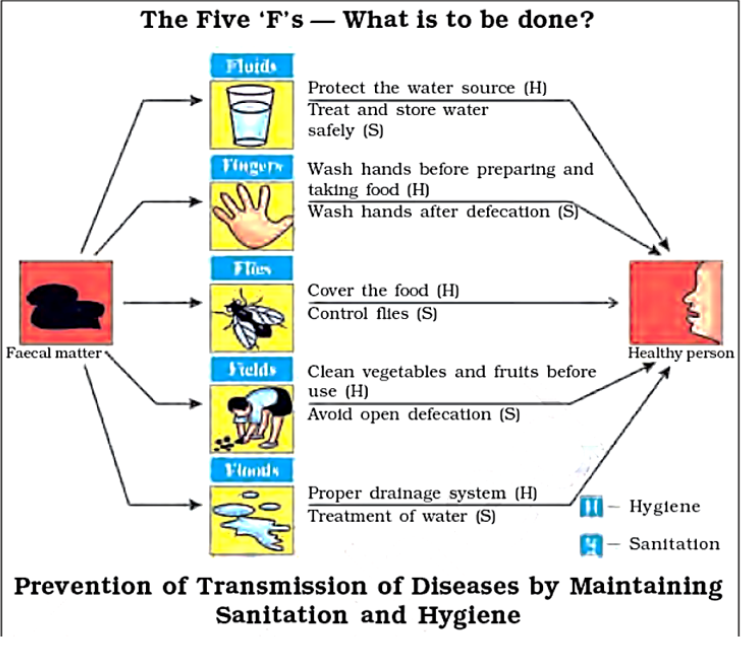
Disease and Its Causes
- Beta, dekho jab bhi koi bimari hoti hai generally kisi na kisi microbe ka infection hota hai ya koi aur karan bhi ho toh bhi uss bimari ke sign and symptoms dikhte hai. Symptoms wo cheeze hai jo aap ka shareer mehsoos kar rha hai jaise ki tez bukhaar, khansi, cheenkein maarna, gala khraab hona, redness ya swelling yeah sab. Signs wo cheezein hai jo doctor dekhta hai, yani ki symptoms jaise ki bukhaar, khansi, sneezing or sath me aapke blood tests, X-rays, MRI, ECG vgarah me usko kya dikh rha hai wo sab sign hote hai kisi particular bimari ke toh wo sab doctor ko chahiyeah yeah decide karne ke liye ki konsa treatment option best hoga.
- jo bimari ek mareej se dusre healthy insaan me fail jaye wo infectious ya communicable disease hoti hai jaise ki TB, common cold, Covid, skin fungal infections and sexually transmitted diseases.
- Jo bimari mareej se kisi or insaan me nhi fail sakti wo non communicable ya non infectious disease kehlati hai. Ex : Cancer, diabetes, janam se koi genetic bimari ho ya hormonal imbalances vgarah.
- Stomach me ulcer (khoon rista hua andruni jakham) high acid amount ke sath sath ek Helicobacter pylori naam ke bacteria ke infection ke karan hota hai toh antibiotic dwa se bacteria ko maar kar hi ulcer ko puri tarah se heal kia jata hai.
Disease and Its Causes
- When there is a disease, either the functioning of one or more systems of the body will change for the worse. These changes give rise to symptoms and signs of disease.
- Symptoms of disease are the things we feel as being ‘wrong’ like headache, cough, loose motions, wound with pus; these are all symptoms. These indicate that there may be a disease, but they don’t indicate what the disease is.
- Signs of disease are what physicians/doctors will look for on the basis of the symptoms. Signs will give a little more definite indication of the presence of a particular disease. Like getting an X-ray, MRI, blood test, Urine test, Stool test, Sputum culture etc. etc.
- Acute Diseases : diseases that last for only very short periods of time. Ex : Common Cold
- Infectious pathogens are the major causes. Pathogens are the disease causing microorganisms like a bacteria, virus, fungi. Other disease causing agents are toxins, poisons, venoms, infectious protein particles, malnourishment, genetic factors etc.
- Infectious Diseases : the disease which can spread from an infected person to a healthy individual is known as infectious disease. Ex : common cold, tuberculosis, HIV infection, parasitic worm infections, fungal infections like athlete’s foot or dandruff.
- Non-Infectious Diseases : disease which can’t be transmitted to a healthy individual. Ex : Cancer, Allergies, Congenital defects, High BP, High blood sugar, hormonal imbalances.
- Highly acidic acid (HCl) is secreted in the stomach of humans to digest the food. It generally does not cause problems but when the individual is stressed or eats a lot of spicy food and has a lot of acid secretion in addition to the infection (discussed shortly), this acid starts to erode the inner lining of the stomach which then becomes inflamed. It can heal on its own or with medication but continued erosion of the inner stomach wall will eventually lead to an ulcer formation which simply is an unhealed internal wound which affects digestion, and could progress to a fatal infection.
- Earlier people used to think that only a high amount of stomach acid is responsible for ulcer formation but Robin Warren and Barry Marshall actually showed that it was a bacteria which caused and inhibited healing of ulcers. When the bacteria is killed with medication the ulcers heals rather fast and completely.
Chronic Diseases : last for a long time, even as much as a lifetime. Ex : Filariasis/Elephantiasis, Cancer, HIV etc.
Causes of Diseases
Peptic Ulcers
Infectious Diseases
- Common cold, flu, AIDS and dengue fever jaisi bimariyaan viruses se hoti hai.
- Typhoid fever, cholera, tb and anthrax jaisi bimariyan bacterias se hoti hai.
- Sleeping sickness and kala azar jaisi bimaria protozoans se hoti hai.
- Skin pe dandruff jaise infections fungi ke karan hote hai vhi small intestine me jo keede hote hai wo generally helminthic worms ke karan hote hai.
- Virus, bacteria, fungi ya protozoans ki kuch apni specificall biochemical reactions ya pathways hoti hai jo unke liye unique hai and medicines se hum unhi ko target karte hai taki medicine keval in pathogens ko nuksaan pahuchaye and human ke tissues ko jitna ho unaffected rakhe. Yhi karan hai ki antibiotics kabhi bhi fungi ya viral infections ke against kaam nhi aati and anti viral medicines kabhi bhi bacteria ko nhi marengi.
- Bimariyaan generally air, contaminated food and water ya exchange of bodily fluids ke dauran failti hai. Common cold and tb jaisi bimariyan air se failti hai. Jab bhi mareej khansi karta hai toh hawa me kuch live pathogens hote hai jo pass khade inhale kar rhe individuals ke respiratory pathway tak travel karke usko bhi infect kar dete hai. Agar kisi infected person ne apne excreta ya baki bodily fluid se food and water infect kar dia or whi food and water agar kisi healthy person ne consume kia toh wo healthy person bhi bimar padega. Yeah route cholera failne ka sabse bdia route hai. Sex ke waqt kaafi bodily fluids exchange hote hai jo sexually transmitted disease ke sath sath fungal skin infections bhi transmit kar sakta hai.
- Har bimari ya yeah kahe ki pathogens ki entry ke routes alag alag hai jinke karan wo alag alag tissues ya organs ko affect karte hai jaise ki air born diseases lagbhag upper respiratory tract and lungs ko affect karti hai and common symptom hoga khansi. Water and food borne infections generally gut ko affect karte hai toh pait me dard hota hai. Wo pathogens gut me bhi reh sakte hai, jaise ki worms ya dusre organs tak travel kar jate hai like hepatitis virus liver tak travel karta hai. Malaria liver and rbcs ko affect karta hai. Encephalitis infection brain ko infect karta hai.
- Jha tak treatment ki baat hai toh 2 main raaste hai : symptomatic relief, jisme keval bimari ke lakshano se rahat di jati hai jaise ki bukhar kam karna ya pain medication and dusra rasta hai, bimari ke karan ko nast karna yani ki disease causing microbes ko medications ke through maar girana.
- Toh commonly used medications are : antibiotics against bacterias, antiviral virus infection ke liye, antifungals fungal infection ke liye, anti-helminthic drugs helminthic infection ke liye etc etc.
- Generally suna hoga na ki ilaaj se bachaav behtar hai toh prevention ka main funda hai disease causing microbe ki entry ko rokna. Mainly entry hoti hai naak ya muh toh mask laga kar rakhna, haatho ko saaf rekhna and ghaav par patti lga kar rakhna - yeah sabhi tareeke hai prevention ke ya further infection ko rokne ke. Safe food and water. Water ko purify karna jisme biofilters ho jo pathogens ko filter out karde. Pathogens ke breeding grounds ko nast karna jasie ki stagnant water sources ko aas paas na rehne dena jisse uss environment me machhar kam honge- yeah sabhi prevention ke tareeke hai.
Infectious Diseases
- Disease caused by viruses are : Common cold, Influenza/flu, dengue fever and AIDS.
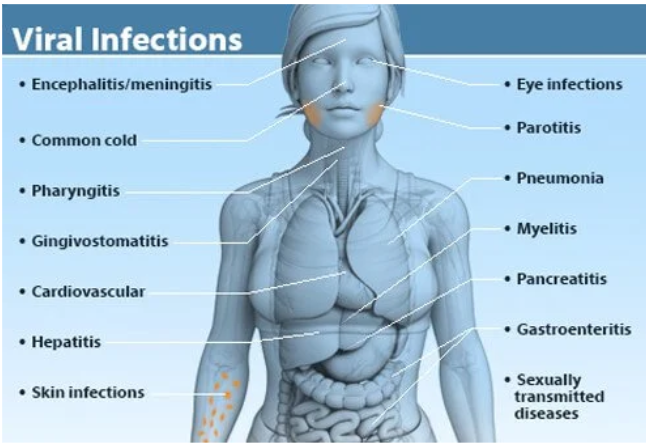
- Diseases like typhoid fever, cholera, tuberculosis and anthrax are caused by bacteria. Acne is caused by Staphylococcus bacteria.
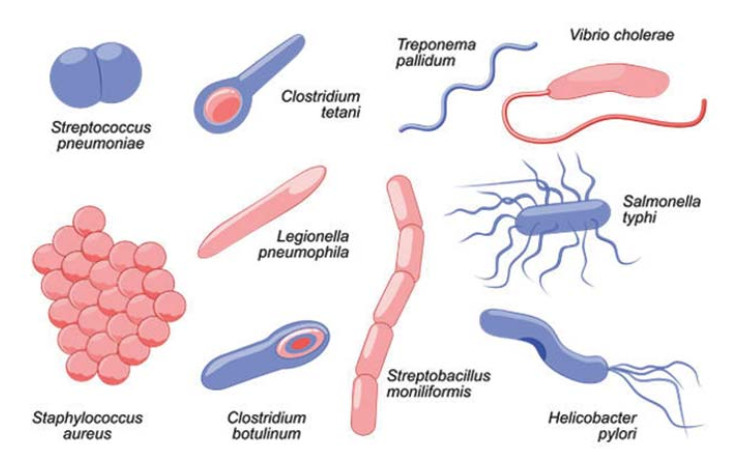
- Many common skin infections are caused by different kinds of fungi.
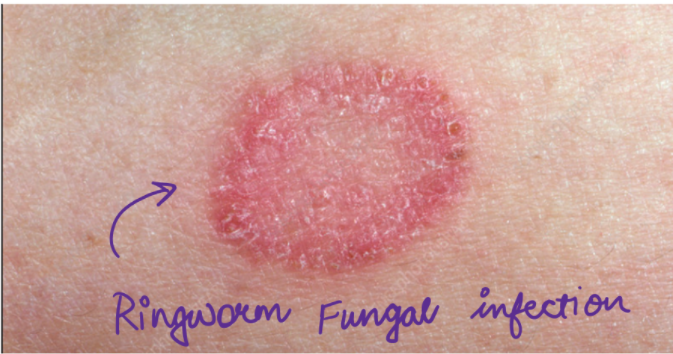
- Protozoan microbes cause many familiar diseases, such as malaria and kala azar (caused by Leishmania). Trypanosoma causes sleeping sickness.
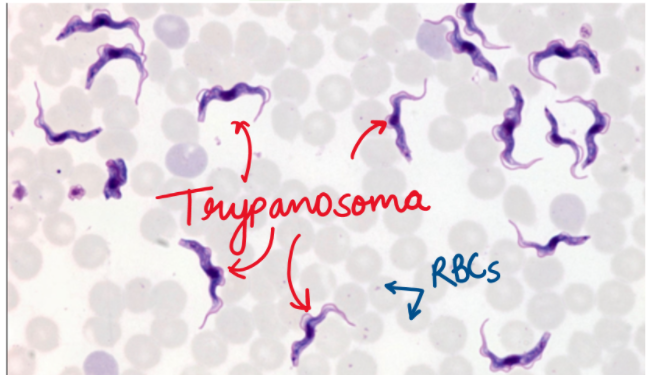

- Parasitic infection are caused by worms like Ascaris lumbricoides.
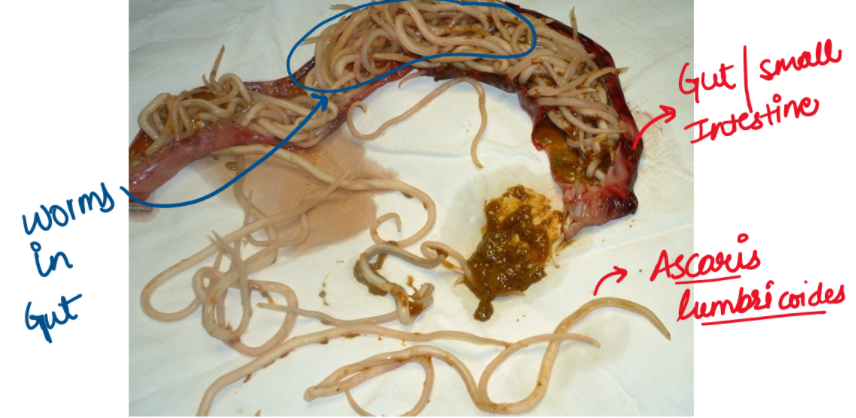
- Viruses, bacteria and fungi multiply very quickly, while worms multiply very slowly in comparison.
- Treatment strategies are generally different for different infections depending upon cause and disease advancement and other factors.
- Antibiotic penicillin blocks the bacterial processes that build the cell wall. As a result, the growing bacteria become unable to make cell-walls, and die easily. Human cells don’t make a cell-wall anyway, so penicillin cannot have such an effect on us. Nowadays, Penicillin isn’t the first choice of drug in many bacterial infections because it doesn’t work anymore so we have developed other antibiotics.
- Antibiotics block biochemical pathways important for bacteria, But viruses do not use these pathways at all, and that is the reason why antibiotics do not work against viral infections like common cold etc.
- Air-borne Diseases : Disease-causing microbes can spread through the air. This occurs through the little droplets thrown out by an infected person who sneezes or coughs. Someone standing close by can breathe in these droplets, and the microbes get a chance to start a new infection. EX : Common Cold, SARS-CoV2 infection, pneumonia, TB etc.
- Diseases can also be spread through water. This occurs if the excreta from someone suffering from an infectious gut disease, such as cholera, get mixed with the drinking water used by people living nearby. Ex : Cholera.
- Microbial infections such as syphilis or AIDS that are transmitted by sexual contact from one partner to the other. However, such sexually transmitted diseases are not spread by casual physical contact. Casual physical contacts include handshakes or hugs or sports, like wrestling.
- Vectors : animals carry the infecting agents from a sick person to another potential host. Ex : Mosquitoes, housefly, cockroach, rats etc
- The disease-causing microbes enter the body through these different means.
- If they enter from the air via the nose, they are likely to go to the lungs. This is seen in the bacteria causing tuberculosis.
- If they enter through the mouth, they can stay in the gut lining like typhoid causing bacteria. Or they can go to the liver, like the viruses that cause jaundice.
- Infection like HIV, that comes into the body via the sexual organs, will spread to lymph nodes all over the body.
- Malaria-causing microbes, entering through a mosquito bite, will go to the liver, and then to the red blood cells.
- The virus causing Japanese encephalitis, or brain fever, will similarly enter through a mosquito bite. But it goes on to infect the brain.
- The signs and symptoms of a disease will thus depend on the tissue or organ which the microbe targets.
- If the lungs are the targets, then symptoms will be cough and breathlessness.
- If the liver is targeted, there will be jaundice.
- If the brain is the target, we will observe headaches, vomiting, fits or unconsciousness.
- Common effects depend on the fact that the body’s immune system is activated in response to infection. Ex : Swelling, pain, redness : the triad of inflammation; fever etc.
- In HIV infection, the virus goes to the immune system and damages its function. Thus, many of the effects of HIV-AIDS are because the body can no longer fight off the many minor infections that we face everyday. Instead, every small cold can become pneumonia.
- Severity of disease manifestations depend on the number of microbes in the body. If the number of microbes is very small, the disease manifestations may be minor or unnoticed. But if the number is of the same microbe large, the disease can be severe enough to be life threatening.
- There are two ways to treat an infectious disease. One would be to reduce the effects of the disease and the other to kill the cause of the disease.
- Case 1 : The symptoms are usually because of inflammation. For example, we can take medicines that bring down fever, reduce pain or loose motions. We can take bed rest to conserve energy.
- Limitations of treatment strategy 1 : disease will not be cured.
- Case 2 : kill the microbes. Antibiotics can kill bacteria, antivirals can take care of viruses, antihelminthic drugs kill helminthic worms, antifungals kill disease causing fungi.
- Making antivirals is harder than making antibiotics. Why ?
→ One reason why making antiviral medicines is harder than making antibacterial medicines is that viruses have few biochemical mechanisms of their own. They enter our cells and use our machinery for their life processes. This means that there are relatively few virus-specific targets to aim at. Despite this limitation, there are now effective anti-viral drugs, for example, the drugs that keep HIV infection under control. - There are two ways, one general (preventing exposure) and one specific to each disease.
- For airborne microbes, we can prevent exposure by providing living conditions that are not overcrowded.
- For water-borne microbes, we can prevent exposure by providing safe drinking water. This can be done by treating the water to kill any microbial contamination.
- For vector-borne infections, we can provide clean environments. This would not, for example, allow mosquito breeding.
- Public hygiene is one basic key to the prevention of infectious diseases.
- The second basic principle of prevention of infectious disease is the availability of proper and sufficient food for Everyone so that they can have a robust immune system to fight infections.
Means of Spread

Principles of Treatment
Principles of Prevention
Immunisation
- Immunity ka matlab hai ki wo state jisme body kisi infection se protected rahe. Immunisation ka matlab hai immunity provide karna. Immune system aapke shareer me cells, factors and fluids ka aisa complex system hai jo aapko infection se bachata hai and agar infection ho jata hai toh ussey ladta hai.
- White blood cells body ke soldiers hai jo immunity maintain karte hai along with a few other cells and proteins.
- Immune cells me memory bnane ki capacity hoti hai jiske karna agar aapko ek baar kisi pathogen se koi bimari ho gyi toh future me same ussi pathogen se vahi bimari nhi hogi for ex : agar kisi ko ek baar chicken pox ho gaya toh lifetime dobara nhi hoga. Yeah hota hai kyunki immune system me memory cells bane hue hai jo same pathogen ke attack se prevent karte hai.
- Edwar Jenner se pehla documented example dia tha immunisation ka jhan par unhone cowpox (mild disease) se peedit milkmaids ke pustules se liquid nikala and healthy individuals me innoculate kar dia jinko baad me small pox bimari se immunity mil gyi kyunki jo pathogen cowpox bimari ke liye responsible hai, small pox ka virus bhi lagbhag same hi hai lekin smallpox ek fatal bimari hai jabki cowpox nhi. Toh iss tareeke se immunity provide karna hi immunisation ya vaccination kehlaya. Aajakl kafi bimariyon jais ki corona virus-2, influenza shots, TB, measles, mumps, polio, diphtheria, tetanus and rabies vgarah ke prati vaccines available hai.
- Always take your vaccines. ALWAYS.
Immunisation
- Immunity is the state of protection from diseases or an infection. So immunisation basically means to immunise an individual against a disease. Its a very old concept used in traditional Indian and Chinese medicinal system.
- Recent documented example is of Edward Jenner who took fluid from individuals infected with cowpox and inoculated this fluid in healthy individuals to protect them from smallpox. This concept was known as vaccination and the individuals were said to be immunised against smallpox. From this incident forward, we tried creating vaccines in order to protect healthy individuals from diseases such has TB, measles, mumps, chicken pox, anti-rabies, diphtheria, whooping cough, hep A, polio, for SARS-CoV2, for tetanus etc. However not all vaccines are made same.
Summary
- Health is a state of physical, mental and social well-being.
- The health of an individual is dependent on his/her physical surroundings and his/her economic status.
- Diseases are classified as acute or chronic, depending on their duration.
- Disease may be due to infectious or non-infectious causes.
- Infectious agents belong to different categories of organisms and may be unicellular and microscopic or multicellular.
- The category to which a disease-causing organism belongs decides the type of treatment.
- Infectious agents are spread through air, water, physical contact or vectors.
- Prevention of disease is more desirable than its successful treatment.
- Infectious diseases can be prevented by public health hygiene measures that reduce exposure to infectious agents.
- Infectious diseases can also be prevented by using immunisation.
- Effective prevention of infectious diseases in the community requires that everyone should have access to public hygiene and immunisation.
